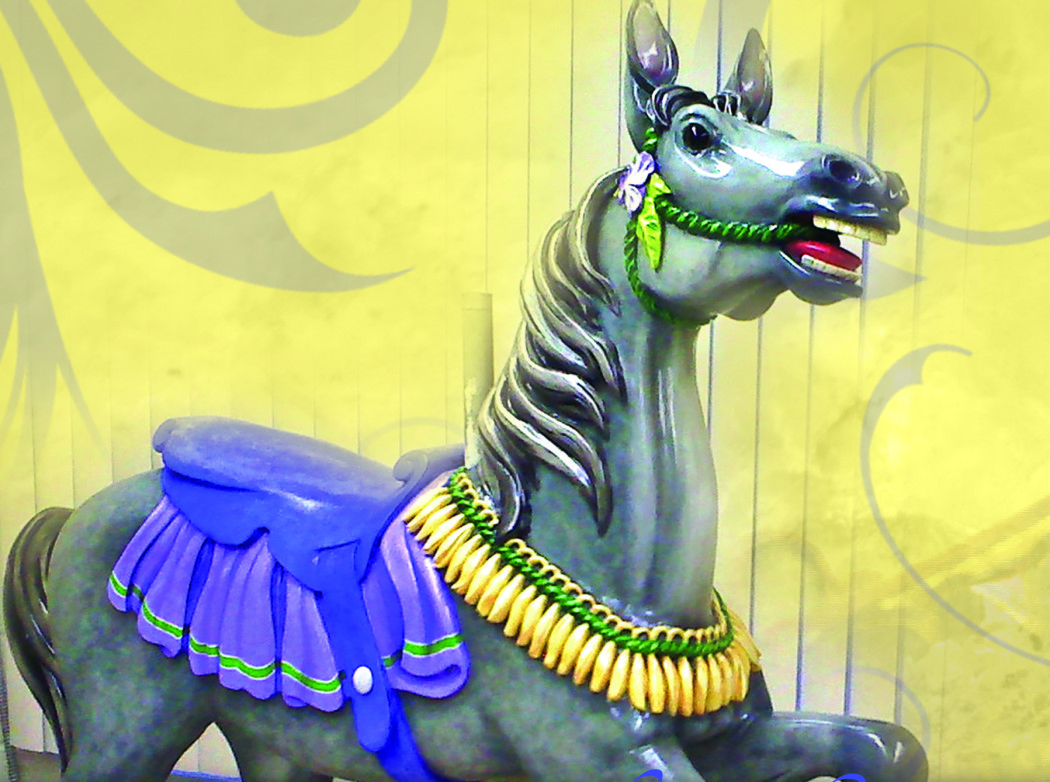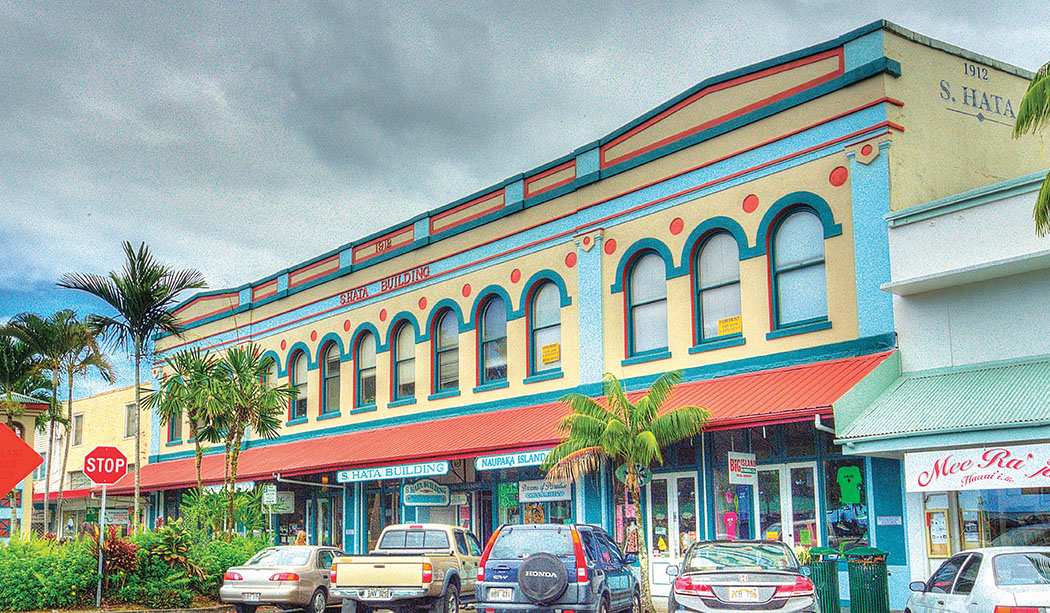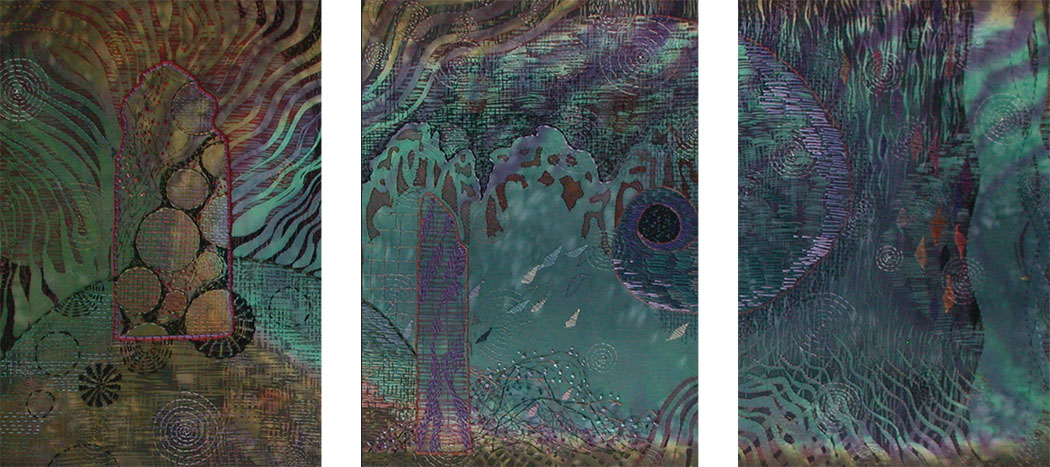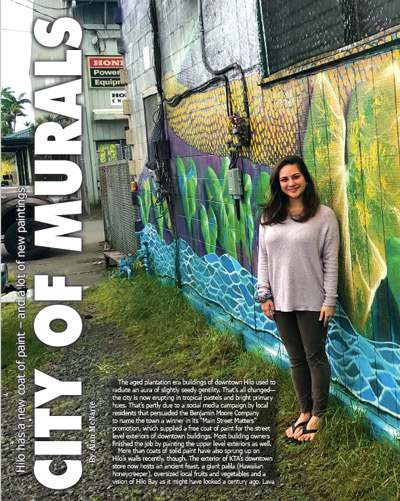
City of Murals
By Alan D. McNarie

The aged plantation era buildings of downtown Hilo used to radiate an aura of slightly seedy gentility. That’s all changed— the city is now erupting in tropical pastels and bright primary hues. That’s partly due to a social media campaign by local residents that persuaded the Benjamin Moore Company to name the town a winner in its “Main Street Matters” promotion, which supplied a free coat of paint for the street level exteriors of downtown buildings. Most building owners finished the job by painting the upper level exteriors as well.
More than coats of solid paint have also sprung up on Hilo’s walls recently, though. The exterior of KTA’s downtown store now hosts an ancient feast, a giant palila (Hawaiian honeycreeper), oversized local fruits and vegetables and a vision of Hilo Bay as it might have looked a century ago. Lava and ocean goddesses cavort on the sides of Spencer’s Gym; another goddess peers serenely from moonlit waves on one wall of Agasa Furniture, and yet another rampages along the side of the Hilo Town Tavern. Across Kalaniana‘ole Avenue from the Port of Hilo, Hawaiian legends spring from the walls of the Keaukaha General Store. On Ponohawai Street, an enormous tako (octopus) scales one wall of a vacant building.
Hilo may be vying for a new nickname: the City of Murals.
More than two dozen of the big public paintings have sprung up around the city—most on downtown businesses, though several also grace civic buildings, public schools and UH-Hilo. A particularly spectacular one by UH-Hilo Hawaiian Studies Program students, sponsored by the O‘ahu-based Estria Foundation’s “Mele Murals” project, now adorns the back of the HPM Building Supply, facing the Edith Kanaka‘ole Tennis Stadium in Hilo’s industrial district.
The murals come in all styles, from realistic to abstract, primativist to surreal; they can be as simple as the giant maile lei that stretches along the side of Verna’s Drive In, or as complex as Rick Hayward and Emily Devers’ intricate interweaving of letters, tropical fruit images and abstract white lines in the parking lot of the Hilo Backpacker’s Hostel. Some of the murals are by schoolchildren— the kids at Connections Charter School have painted two, for instance. Others sprang from the imaginations of nationally or internationally known artists, but almost all actually are the work of many hands: true community efforts.
In the Beginning
Hilo’s mural movement started in 2009, when local artist Kathleen Kam had a casual meeting with Alice Moon of the Hilo Downtown Improvement Association. “I looked at her and said, ‘What if I could do a mural?’” recalls Kathleen. She was already known for other murals she’s painted, such as the forest scene that graces the side of the Kilauea General store in Volcano. She suggested that a similar project could serve as a “gateway todowntown Hilo.”
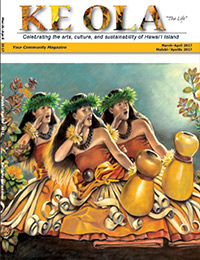
Alice liked the idea, and passed the suggestion on to then HDIA President Jeff Melrose. Jeff met with Kathleen a few days later; they strolled downtown Hilo together, looking at possible mural sites, and settled on one wall of the renovated downtown KTA Supermarket.
KTA officials enthusiastically came on board: when Kam offered to paint Hilo’s first downtown mural for free, the store offered to pay for a second mural panel beside it. The first, they agreed, would be a scene of old Hilo Bay, with local people engaged in traditional activities such as fishing and lei-making along the shore, plus traditionally rigged sailing canoes and a bridge-less Coconut Island in the background.
The second panel would feature locally grown foods. “They wanted something that would reflect that they support the farmers and fisherman by purchasing all their goods to sell in the store,” recalls Kathleen.
Those themes of Hawaiian heritage and sustainability would be echoed in many murals to come. Kathleen’s work process would also set precedents: she made the mural into a public participation event. “I would park my van every morning at seven o’clock, have my paints premixed, and would work with anyone who showed up to help,” she recalls. Students, other artists, downtown residents and businesspeople, even tourists and street people were all invited to help sand down the plywood panels, then lay on the base coat of background paint.
Kathleen then sketched in the mural’s outlines, and volunteers began filling in basic colors. They also served as models: Hilo residents strolling by the mural today may recognize familiar faces, including those of Alice Moon, who has since passed away, and her sister Sara; Jeff Melrose, and some former UH students, among others. Kathleen’s former art teacher, Richard Crawford, posed with a fisherman’s throw net.
Others contributed special expertise. Local fisherman advised Kathleen about the mural’s fish; Kamehameha School students painted the taro leaves. A local tattoo artist painted the figures’ tattoos.
Other murals have since joined Kathleen’s originals along KTA’s long wall. With the sponsorship of the Mauna Kea Forest Restoration project, Kathleen painted another mural in KTA’s parking lot: a far-larger-than life portrait of a palila, the little endangered silver-and-gold honeycreeper of the island’s upland māmane forests.
From Hip-Hop to Hawaiian Culture
Keaukaha General Store sits sandwiched between the Port of Hilo and the city’s industrial district, at the head of the Native Hawaiian neighborhood of Keaukaha. Founded by Breeani Sumera-Lee and her mother, Kim Kimi, about four years ago, the store sells food and dry goods with a strong emphasis on local products, from honey to hats, and it’s wrapped in Hawaiian myths and legends—literally.
The Mauna Kea Mural, based on a birth mele (song) for King Kamehameha III, covers one whole side of the store and aptly sums up how Hawaiian culture views its people’s relationship to the earth. The King’s bloodline includes more than people: it traces back to Wākea, the sky god, whose children include not just the first Hawaiian human, but gods, rains, Mauna Kea and the kalo (taro) plant. The mural traces their connections from the snow goddess Poli‘ahu all the way down to the waters that flow into Keaukaha’s ocean-side freshwater springs.
Occupying another exterior wall is a second mural, in which each letter of the word “aloha” calls forth Keaukaha’s local legends, such as two giant mo‘o (lizards) associated with the area and Lono, the wise god of peace and fertility who was said to have been born in Keaukaha.
The lead artist for both murals is John Hina, who calls himself “Prime,” an O‘ahu native and former hip-hop tagger who grew up, raised a family, and then returned to his spray cans as a way to lead Hawaiian young people back to their culture. His nonprofit, 808 Urban, has been painting murals all over the islands for more than nine years. “To take this concept of what everybody thinks of as graffiti, as vandalism, and turn it into an art form was new to people in 2007,” he muses.
What he does now is light years away from vandalism. For the Keaukaha murals, he started by consulting local kūpuna for legends and history tied to the community. Then, like Kathleen, he drew in the community to help with the painting: from local school kids to famous Keaukaha residents such as aloha wear designer Sig Zane. The mural has become a focal point of neighborhood pride.
Audio summaries of both murals can be heard by dialing the store’s phone line. “We’ve had so much feedback from people who were calling the number on the wall who said they’d never heard that story before,” says Breeani.
Sustainable Dreams
Several of the city’s most recent murals are the products of another Hawai‘i-based organization called Temple Children. While Prime’s 808 Urban promotes art and Hawaiian Culture, Temple Children attempts to simultaneously foster art and sustainability.
The group, founded by Miya Tsukazaki and Dave Hooke, a.k.a “MEGGS,” was formed as “a creative platform for the collaboration of the socially and environmentally minded.” It has sponsored about nine murals in Hilo, so far. Some are by local lead artists such as Brandi Serikaku, whose colorful abstract interpretation of Hilo’s famous rain pelts down one wall of an alley off Hilo’s bayfront.
Other murals were created by established artists that the group has recruited from elsewhere: Rick Hayward and Emily Devers, for instance, who paint as “Frank and Mimi,” hail from Brisbane, Australia, while Lauren YS, who did the rampant surreal goddess on Hilo Town Tavern, is based in the Bay Area. “We are working with people that we know very well: people who are involved in global consciousness, people who want to contribute to the greater good,” explains Miya.
When those artists come here, it’s a two-way journey. They expose Hilo to international-quality art, and in turn, they’re exposed to Hawaiian culture, Hawaiian sustainable practices and Hawaiian foods. “One of our goals was to feed everyone (on the mural projects) as near to 100 percent island grown and raised foods as possible,” notes Miya. The artists also find out where those foods come from—one way is spending a day in Waipi‘o Valley and working in a lo‘i (taro patch) there.
As well as learning Hilo’s past, they get to participate in its future. The old plantation town is rebirthing itself as a seedbed of small businesses: family restaurants, mom-and-pop stores, entrepreneurs’ personal dreams. The murals compliment those dreams, giving them personality and publicity.
Take, for example, Oasis Skateboards, the dream child of owner Dan Madsen, who also happens to be an artist. He’s responsible for that giant tako climbing the empty building on Ponohawai. When Temple Children approached him about using his shop for their first Hilo mural, he jumped at the opportunity. “I was really excited when they approached us,” he recalls. “I’m more excited when someone approaches me about doing my shop than about my own art.” For the skateboard shop, MEGGS created a design featuring 1970-80s skateboarding legend Tony Ava bursting out of a lush undergrowth of tropical foliage.
Maria Short saw the skateboard mural and took notice. She contacted Temple Children to create something for her own dream child: Short n Sweet Bakery on Kino‘ole St. For her shop, MEGGS and Honolulu artists Matthew and Roxanne Ortiz, who co-create under the nom de plume of “Wooden Wave,” did a piece of whimsical prophecy: a giant boat that houses, among other things, a bakery and a skateboard ramp—as well as solar panels, rainwater catchment, terraced gardens and as many other “community-minded sustainable systems as possible…that would conceivably meet the needs of an eco-conscious, fun-loving, ocean-bound community,” explains the wooden plaque that the artists gave Maria.
More shop owners soon lined up to have their dreams “muralized”. The process continues. Nearly all the artists interviewed for this story already have plans for new projects.
“There’s a lot of blank walls out there yet,” notes Dan.
Contact Temple Children: miva@templechildren.com
Contact Keaukaha General Store: keaukahageneralstore.com/contact
Contact The Astria Foundation and Mele Murals: estria.org/contact
Contact Prime and 808 Urban: 808urban.org
Contact writer Alan McNarie: amcnarie@yahoo.com
